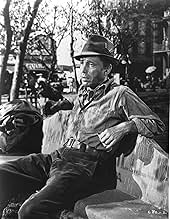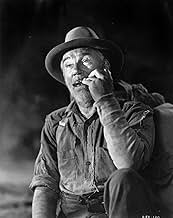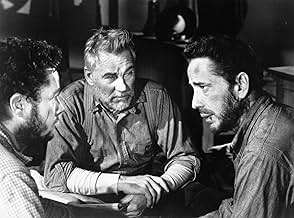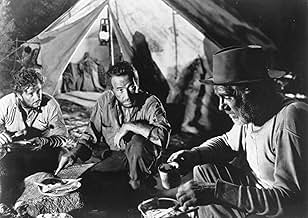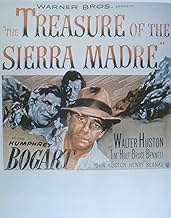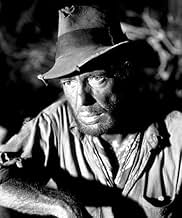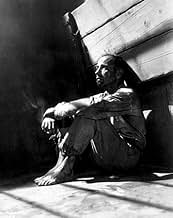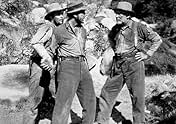Two down-on-their-luck Americans searching for work in 1920s Mexico convince an old prospector to help them mine for gold in the Sierra Madre Mountains.Two down-on-their-luck Americans searching for work in 1920s Mexico convince an old prospector to help them mine for gold in the Sierra Madre Mountains.Two down-on-their-luck Americans searching for work in 1920s Mexico convince an old prospector to help them mine for gold in the Sierra Madre Mountains.
- Won 3 Oscars
- 18 wins & 5 nominations total
Barton MacLane
- Pat McCormick
- (as Barton Mac Lane)
Arturo Soto Rangel
- Presidente
- (as A. Soto Rangel)
Manuel Dondé
- El Jefe
- (as Manuel Donde)
José Torvay
- Pablo
- (as Jose Torvay)
Robert Blake
- Mexican Boy Selling Lottery Tickets
- (uncredited)
Guillermo Calles
- Mexican Storeowner
- (uncredited)
Roberto Cañedo
- Mexican Lieutenant
- (uncredited)
Spencer Chan
- Proprietor
- (uncredited)
Jacqueline Dalya
- Flashy Girl
- (uncredited)
Ralph Dunn
- Flophouse Bum
- (uncredited)
Ernesto Escoto
- Mexican Bandit
- (uncredited)
- Director
- Writers
- All cast & crew
- Production, box office & more at IMDbPro
Summary
Reviewers say 'The Treasure of the Sierra Madre' is a critically acclaimed classic, lauded for its profound examination of greed, betrayal, and human nature. John Huston's direction and screenplay, alongside exceptional performances by Humphrey Bogart, Walter Huston, and Tim Holt, are often celebrated. The film's authentic atmosphere, intricate character studies, and moral complexities deeply resonate. Although some critique its pacing and subplots, most regard it as a timeless masterpiece noted for its psychological depth and thematic richness.
Featured reviews
This film made a huge impression on me when I first saw it at the age of 15 or 16. A recent rewatching on DVD really served to bring home for me what makes this film so special.
The whole thing is quite good, but it really hits you when Howard goes off to celebrate with the Indians, leaving Dobbs and Curtin to care for his gold and burros. The ensuing scenes of their spiraling mistrust and tension are absolutely spellbinding--the kind of thing that makes you lean forward in your seat just to get your eyes a little closer to the raw humanity unfolding in front of you. Their paranoia, the way you can SEE scenarios of betrayal dancing in their eyes, Dobbs' burgeoning madness--these are the moments that make this film one for the ages.
At its best, film noir (which this most certainly is--Western surroundings or no) makes the viewer complicit in the evil depicted on screen. We find ourselves scheming and plotting in our heads along with the unsavory characters we are watching--we start to feel the same temptations and desires that they do. "Treasure of the Sierra Madre" accomplishes this bond with the audience as well as any film you are likely to see.
A magnificent film--one of the few great screen tragedies.
The whole thing is quite good, but it really hits you when Howard goes off to celebrate with the Indians, leaving Dobbs and Curtin to care for his gold and burros. The ensuing scenes of their spiraling mistrust and tension are absolutely spellbinding--the kind of thing that makes you lean forward in your seat just to get your eyes a little closer to the raw humanity unfolding in front of you. Their paranoia, the way you can SEE scenarios of betrayal dancing in their eyes, Dobbs' burgeoning madness--these are the moments that make this film one for the ages.
At its best, film noir (which this most certainly is--Western surroundings or no) makes the viewer complicit in the evil depicted on screen. We find ourselves scheming and plotting in our heads along with the unsavory characters we are watching--we start to feel the same temptations and desires that they do. "Treasure of the Sierra Madre" accomplishes this bond with the audience as well as any film you are likely to see.
A magnificent film--one of the few great screen tragedies.
Tampico sets the scene for the start of speculation, Fred C. Dobbs is out of cash and his luck is in cessation, but an encounter in flophouse, and big dreams emerge and arouse, as a plan is born with Howard, and a fellow who's called Curtin. Into hills laden with gold, our companions then embark, finding seams that come alive with golden riches to impart, building up substantial fortune, thinking soon they will be tycoons, but there's one who's trust is waning and has sores that start to smart. The journey back becomes a challenge to them all, as one by one the group is scattered, battered, stalled, will their work be well rewarded, will endeavours all be thwarted, either way, you will be engaged, and quite possibly enthralled.
Bogarts best performance.
Bogarts best performance.
This film is a sharp-edged study of the effects of greed on otherwise normal men, and one man in particular: Bogart's Fred C. Dobbs. Dobbs and Bob Curtin (Tim Holt) are down and out and meet up with prospector Howard (Walter Huston). When Dobbs wins a lottery, he uses the proceeds to finance a trip for the three to central Mexico to search for gold.
The three have to deal with the lawlessness of central Mexico at the time - bandits were actually on the loose in that country killing anybody with stuff, and taking that stuff. The Federales were a violent solution to a violent problem - killing the bandits after a summary judgement and the bandits having dug their own graves. So our trio not only have to worry about bandits once they strike gold, they have to worry about the darkness of their own souls.
In the beginning, Bogart's Fred C. Dobbs is a decent guy who does not take advantage of others. Dobbs only takes his money from the guy that wouldn't pay and he does share his lottery ticket and is generous with his fellow miners, but as greed begins to take root in him, little by little we see his goodness eaten away. It's a great credit to the writing and Bogart's skills that this is done gradually and played out over time. Incidentally, that's director John Huston "staking him to a meal". One of the best director cameos ever (although Polanski in Chinatown is equally great)!
Dobbs overestimates himself and the fallibility of human nature. Walter Hustons character freely admits what gold could do to any of them including himself. Dobbs is sure it will never happen to him, but he's never had anything, so he's never faced temptation, and when he falls it's a long way down.
This may be Tim Holt's finest performance - it was probably his finest opportunity given he had spent years laboring as a B western star on the RKO lot. Walter Huston as the prospector, minus his dentures and plus a bunch of pounds and with holes in his clothes is not the debonair fellow you are used to seeing in film . If Mary Astor's character in Dodsworth could have thought this was the future appearance of the man she loved, would she have taken her gondola in the other direction? I guess we'll never know.
Highly recommended as one of the great character studies in which several characters get studied in detail.
The three have to deal with the lawlessness of central Mexico at the time - bandits were actually on the loose in that country killing anybody with stuff, and taking that stuff. The Federales were a violent solution to a violent problem - killing the bandits after a summary judgement and the bandits having dug their own graves. So our trio not only have to worry about bandits once they strike gold, they have to worry about the darkness of their own souls.
In the beginning, Bogart's Fred C. Dobbs is a decent guy who does not take advantage of others. Dobbs only takes his money from the guy that wouldn't pay and he does share his lottery ticket and is generous with his fellow miners, but as greed begins to take root in him, little by little we see his goodness eaten away. It's a great credit to the writing and Bogart's skills that this is done gradually and played out over time. Incidentally, that's director John Huston "staking him to a meal". One of the best director cameos ever (although Polanski in Chinatown is equally great)!
Dobbs overestimates himself and the fallibility of human nature. Walter Hustons character freely admits what gold could do to any of them including himself. Dobbs is sure it will never happen to him, but he's never had anything, so he's never faced temptation, and when he falls it's a long way down.
This may be Tim Holt's finest performance - it was probably his finest opportunity given he had spent years laboring as a B western star on the RKO lot. Walter Huston as the prospector, minus his dentures and plus a bunch of pounds and with holes in his clothes is not the debonair fellow you are used to seeing in film . If Mary Astor's character in Dodsworth could have thought this was the future appearance of the man she loved, would she have taken her gondola in the other direction? I guess we'll never know.
Highly recommended as one of the great character studies in which several characters get studied in detail.
Some movies have certain scenes in them that hold the viewers interest more than others. However every single scene in this film holds the viewers interest. There is never a dull or lagging moment. Three down and outers who at one time in their lives were maybe up and comers strike out in search of a fortune or at least enough to live better than they have been.
While Humphrey Bogart gives a superb performance it is Walter Huston who turns in the greatest performance as the old prospector Howard. The scene in the Indian village where he helps to restore a comatose child is one of the most touching in all of film history and is done virtually without any dialog. Mexican character actor Alfonso Bedoya of course steals all the scenes he appears in and delivers his classic "Stinking Badges" line. (what person would dress up as a Bandito for a costume party and not want to look exactly like Bedoya's Gold Hat character?) This film probably should have been a little higher on AFI's top 100. A must see!
While Humphrey Bogart gives a superb performance it is Walter Huston who turns in the greatest performance as the old prospector Howard. The scene in the Indian village where he helps to restore a comatose child is one of the most touching in all of film history and is done virtually without any dialog. Mexican character actor Alfonso Bedoya of course steals all the scenes he appears in and delivers his classic "Stinking Badges" line. (what person would dress up as a Bandito for a costume party and not want to look exactly like Bedoya's Gold Hat character?) This film probably should have been a little higher on AFI's top 100. A must see!
In the 1920's, labor was hard to find. If you happened to be a laborer, work was almost non existent. Indeed, if you were unemployed and in Mexico, your chances were dismal. Yet, these were the times, which attracted many South of the border. The place was barren, yet many a fortune could spring up directly before you, . . .if you were luckily enough to see it. That is the story behind this incredible film. The legend of El Dorado was only one of the many myths which lured the adventurous to Mexico, another was "The Treasure of the Sierra Madre." The gold of the Mother of Mountains was passed from father to son for generations. Thus when the film adaption was made, it was sure to be sculpted by men of vision. One such man is legendary John Huston who directed this film. Three common men are lured by the promise of discovering a lost treasure. The first is Fred C. Dobbs (Humphrey Bogart) a nice enough guy who wants only to be fair, but is hungry to 'strike it rich.' The second is Howard, (Walter Huston) as honest as you expect him to be and a man of considerable experience. The last is Bob Curtin (Tim Holt) who if given a chance, will use it. The trio make a PAC to share and share alike all the treasure they find. However, only Howard is aware of what the possession of Gold can do to a man. To find the treasure, they need the mountain, some hard work, a little luck. To bring it home, will require something only one of them possesses. The film is a Classic and is due to the combined talents of all the stars and the director. If you look closely, you'll see Robert Blake (Barreta) and John Huston in brief roles. ****
Did you know
- TriviaJohn Huston stated that working with his father on this picture and his dad's subsequent Oscar win were among the favorite moments of his life.
- GoofsAlthough set in the 1920s, many of the cars on the streets of Tampico are of 1930s and 1940s vintage; likewise, women, when prominently seen, are groomed and dressed strictly in the style of the 1940s.
- ConnectionsFeatured in The Screen Writer (1950)
- SoundtracksBelieve Me If All Those Endearing Young Charms
(1808) (uncredited)
Music traditional
Played on harmonica by Walter Huston
Details
- Release date
- Country of origin
- Languages
- Also known as
- El tesoro de la Sierra Madre
- Filming locations
- Kernville, California, USA(Kelly's Rainbow Mine)
- Production company
- See more company credits at IMDbPro
Box office
- Budget
- $3,000,000 (estimated)
- Gross US & Canada
- $5,014,000
- Opening weekend US & Canada
- $144,074
- Jan 14, 2018
- Gross worldwide
- $5,014,124
- Runtime
- 2h 6m(126 min)
- Color
- Aspect ratio
- 1.37 : 1
Contribute to this page
Suggest an edit or add missing content


